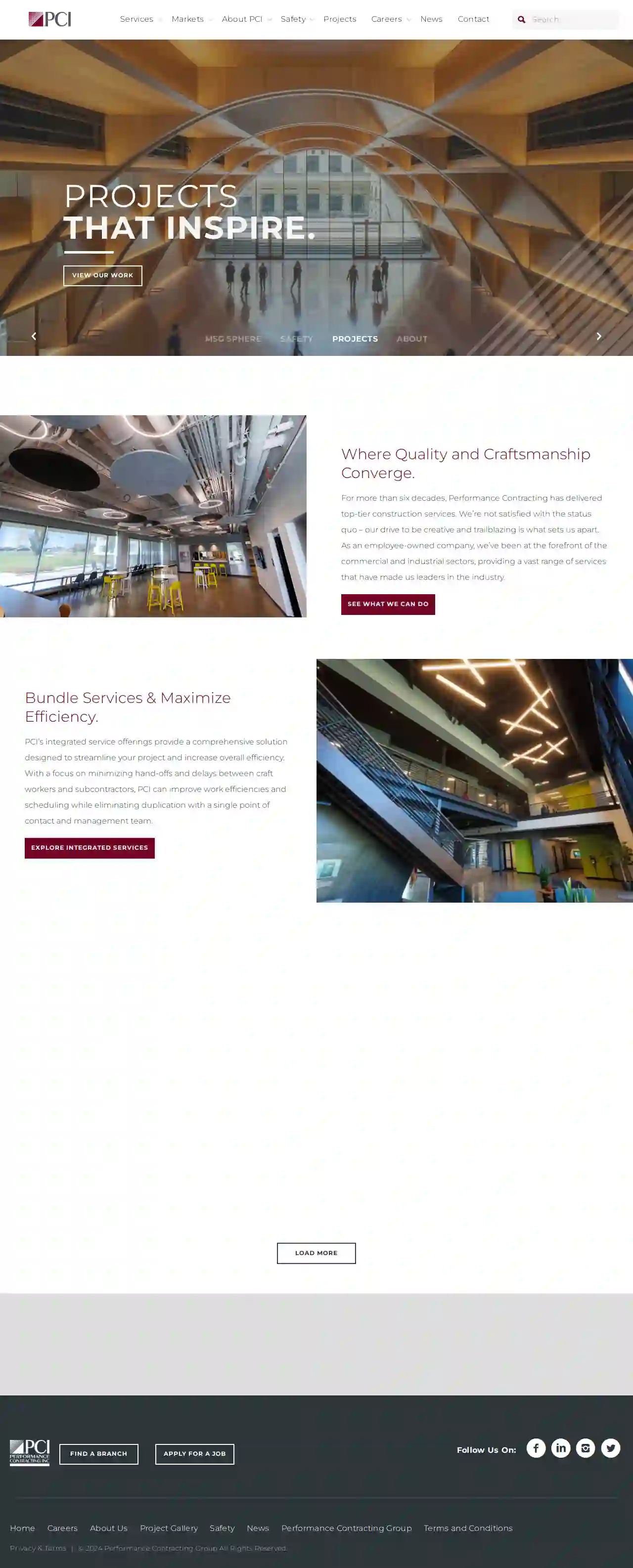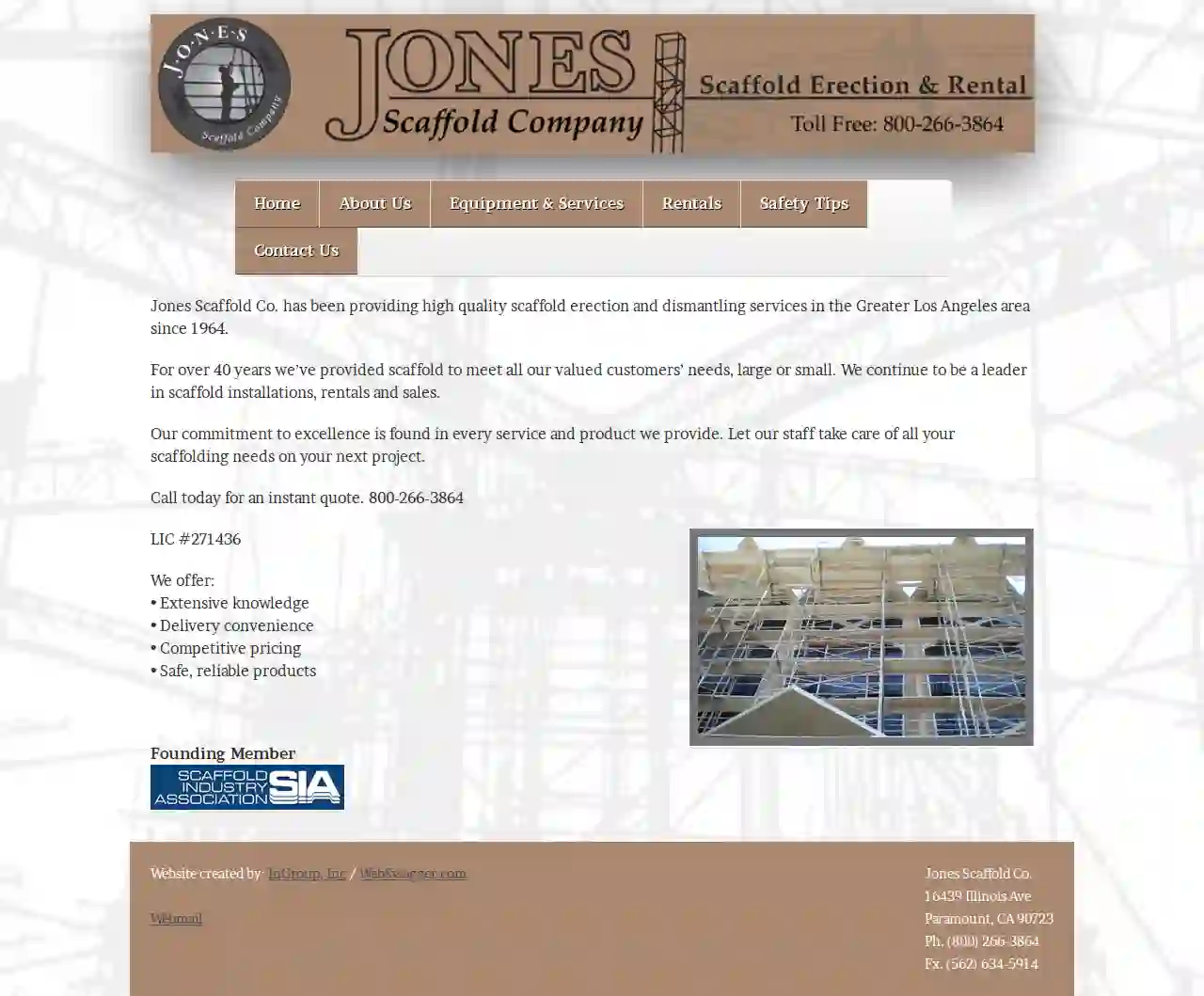Scaffolding Companies Ukiah
Top 10 Scaffolding Specialists in Ukiah
Receive multiple Scaffolding Builders quotes for your project today! Compare profiles, reviews, accreditations, portfolio, etc... and choose the best deal.

PCI Scaffold & Insulation
3.65 reviews123 Main St, Springfield, IL, 12345, USPerformance Contracting, Inc. is a leading specialty contractor in the United States, offering a wide range of services and solutions tailored to the specific needs of diverse market sectors. With over 60 years of industry experience, PCI delivers top-tier construction services, focusing on minimizing hand-offs and delays between craft workers and subcontractors to improve work efficiencies and scheduling. PCI's integrated service offerings provide a comprehensive solution designed to streamline projects and increase overall efficiency.
- Services
- Why Us?
- Accreditations
- Our Team
- Testimonials
- Gallery
Get Quote
D L Scaffolding Inc
54 reviewsSan Rafael, USAt DL Scaffolding Inc, we provide safe, high-quality, and timely scaffold services to our clients in the San Francisco Bay Area and beyond. With a strong focus on trust, integrity, dependability, efficiency, detail-orientedness, and timeliness, we strive to deliver exceptional results that meet our clients' specific project needs. Our team of experts offers a range of services, including scaffold design and planning, scaffold erection, scaffold dismantling, scaffold rental, deliver and pick-up, and project management. We take pride in our ability to provide end-to-end scaffold services that ensure on-time completion and adherence to safety standards.
- Services
- Why Us?
- Gallery
Get Quote
Power Scaffold Service
4.52 reviews157 East Terrance Way, Bakersfield, 93307, USAt Power Scaffold Services, we build long-lasting relationships with our clients by working closely with them to understand and anticipate their needs. We provide cost-effective solutions that enable our clients to complete their projects safely, on-time, and according to plan. Our top-notch, versatile team has erected and dismantled scaffolds for hospitals, theaters, restaurants, oil refineries, power plants, chemical plants, cement plants, and water treatment plants using our state of the art, long-lasting, and durable Cup-Lock Scaffold System.
- Services
- Why Us?
- Accreditations
- Gallery
Get Quote
Major Scaffold, Inc.
55 reviews2908 E Hullett St, Long Beach, 90805, USMajor Scaffold, Inc. is a leading provider of scaffolding solutions in Southern California. With over 25 years of professional experience, the company is dedicated to providing quality services and building valued working relationships with its customers. Their commitment to safety, quality, and quick response service sets them apart from competitors. They offer a wide range of scaffolding solutions including frame scaffolds, pin lock systems, shoring, platforms, stair towers, rolling scaffolds, pedestrian canopies, netting containment, shrinkwrap containment, and trash chutes. Their team is experienced and dedicated to solving everyday scaffolding needs efficiently and effectively.
- Services
- Why Us?
- Accreditations
- Our Team
- Testimonials
- Gallery
Get Quote
Scaffolding Los Angeles
53 reviews123 Scaffolding Lane, Los Angeles, CA, 90001, USScaffolding Los Angeles is the leading Los Angeles and Southern California supplier of the highest quality scaffolding. With over 20 years of experience and professionalism, we offer a complete range of services, including rental and sales to erecting and dismantling. Our goal is to help your team succeed in their work. We are committed to producing results of the highest quality and have the highest commitment to safety. We supply top of the line products and follow OSHA standards to allow you to handle your work safely.
- Services
- Why Us?
- Accreditations
- Our Team
- Testimonials
- Gallery
Get Quote
Jones Scaffold Co
3.25 reviews16439 Illinois Ave, Paramount, 90723, USJones Scaffold Co. has been providing high quality scaffold erection and dismantling services in the Greater Los Angeles area since 1964. For over 40 years we’ve provided scaffold to meet all our valued customers’ needs, large or small. We continue to be a leader in scaffold installations, rentals and sales. Our commitment to excellence is found in every service and product we provide. Let our staff take care of all your scaffolding needs on your next project. Call today for an instant quote. 800-266-3864 LIC #271436 We offer: Extensive knowledge Delivery convenience Competitive pricing Safe, reliable products Founding Member
- Services
- Why Us?
- Gallery
Get Quote
INTEGRATED SCAFFOLDING CONCEPTS
54 reviews11924 Old Stage Road, Chester, 23836, USAt Integrated Scaffolding Concepts, we're your trusted partner in scaffolding excellence since 2015. Our seasoned team of professionals is unwavering in its commitment to delivering the pinnacle of scaffolding solutions tailored to your specific project requirements. We offer more than just scaffolding; we provide a solid foundation for your ambitions. Our adept engineers can craft a scaffold system that harmonizes seamlessly with the most demanding environments, ensuring a secure and reliable working platform for all your access needs. Our ethos revolves around a dual commitment: functionality and safety. These are paramount considerations not only during the setup phase but throughout the entire lifecycle of your project. We recognize that scaffolding is an indispensable asset, integral to every facet of your undertaking. Discover how ISC can elevate your scaffolding experience, setting a new standard for excellence and safety in your projects. Trust in our expertise and let us be your scaffolding partner of choice.
- Services
- Why Us?
- Our Team
- Gallery
Get Quote
Royal Bay Scaffold, LLC
512 reviews4096 Piedmont Avenue Suite#616, Oakland, 94611, USRoyal Bay Scaffold is a scaffolding rental and services company based in Oakland, California. We provide superior scaffold solutions, reliable services, and competitive pricing. Our team members have 14 years of experience in the industry, and our company was established in 2017. We offer a range of services, including erecting and dismantling scaffold, pedestrian walkways, netting/mesh, and system & walk-thru frames scaffolds. We service all trades and are committed to safety, with a focus on OSHA safety rules and regulations. At Royal Bay Scaffold, we take pride in providing quality and safety services. We understand the importance of safety in the workplace and strive to maintain our reputation as skilled scaffolders. Our team members are dedicated to providing excellent service and ensuring that our clients' projects are completed safely and efficiently.
- Services
- Why Us?
- Accreditations
- Gallery
Get Quote
BrandSafway Services Benicia
4.25 reviewsVallejo, USBrandSafway is a leading provider of access solutions, including scaffolding, aerial work platforms, and forming and shoring. With a strong commitment to safety, quality, and customer satisfaction, BrandSafway delivers innovative solutions to meet the unique needs of clients across various industries. Their team of experts works closely with clients to understand their requirements and provide tailored solutions that enhance efficiency, productivity, and safety on site. BrandSafway's mission is to provide exceptional service, quality, and safety to their clients, ensuring successful project outcomes.
- Services
- Why Us?
Get Quote
Rolls Scaffold Inc.
58 reviewsP.O. Box 7909, 93006, USRolls Scaffold, Inc. has proudly served the scaffolding needs of our clients in Southern and Central California since 1958. Our safety record is the basis for our business, and safety begins with equipment selection. The knowledgeable sales staff at Rolls will work with you to determine your unique job requirements and the equipment that meets the task. We offer on-site evaluations to ensure you have the best and most cost-effective equipment and setup to complete your project safely and successfully.
- Services
- Why Us?
- Testimonials
- Gallery
Get Quote
Over 2,353+ Scaffolding Contractors in our network
Our scaffolding contractors operate in Ukiah and surrounding areas!
ScaffoldingHQ has curated and vetted Top Scaffolding Contractors arround Ukiah. Find the most reliable business today.
Frequently Asked Questions About Scaffolding Companies
- Experience: 'How long have you been in business, and what experience do you have with projects like mine?'
- Licensing and Insurance: 'Are you fully licensed and insured, and can I see proof of coverage?'
- Safety Record: 'What are your safety procedures, and how do you ensure worker safety on the job site?'
- References: 'Can you provide references from previous clients?'
- Quotes and Costs: 'Can you provide a detailed quote that outlines all costs, including materials, labor, and any additional services?'
- Project Timeline: 'What is the estimated timeframe for scaffolding erection and dismantling?'
- Communication: 'How will you communicate with me throughout the project?'
- Project Size and Complexity: The height, configuration, and accessibility of the scaffolding will influence the amount of materials and labor required.
- Scaffolding Type: Different scaffolding systems (tube and clamp, system scaffolding, suspended scaffolding) have varying costs.
- Duration of Rental: The length of time you need the scaffolding will affect the overall rental price.
- Location: Labor costs and material availability can differ based on your location.
- Additional Services: Some companies may offer additional services like erection, dismantling, or transportation, which can add to the cost.
- Steel: The most common material due to its strength, durability, and resistance to corrosion.
- Aluminum: Lighter than steel, often used for smaller projects or where weight is a concern.
- Timber: Used for decking platforms and some traditional scaffolding structures. It's less common now due to its susceptibility to rot and damage.
- Fiberglass: Used in specialized applications where electrical conductivity is a concern.
- A temporary structure with a larger platform for workers and materials.
- Offers greater stability and working space.
- Suitable for tasks requiring movement and multiple workers.
- Used for higher elevations and more complex projects.
- Used for reaching specific points at height for short durations.
- Less stable than scaffolding, requiring more caution and balance.
- Not suitable for tasks involving heavy materials or extended work periods.
What questions should I ask a scaffolding company before hiring them?
How much does scaffolding cost to hire in the USA?
What are some common materials used in scaffolding?
What is the difference between a scaffold and a ladder?
Scaffolding:
What questions should I ask a scaffolding company before hiring them?
- Experience: 'How long have you been in business, and what experience do you have with projects like mine?'
- Licensing and Insurance: 'Are you fully licensed and insured, and can I see proof of coverage?'
- Safety Record: 'What are your safety procedures, and how do you ensure worker safety on the job site?'
- References: 'Can you provide references from previous clients?'
- Quotes and Costs: 'Can you provide a detailed quote that outlines all costs, including materials, labor, and any additional services?'
- Project Timeline: 'What is the estimated timeframe for scaffolding erection and dismantling?'
- Communication: 'How will you communicate with me throughout the project?'
How much does scaffolding cost to hire in the USA?
- Project Size and Complexity: The height, configuration, and accessibility of the scaffolding will influence the amount of materials and labor required.
- Scaffolding Type: Different scaffolding systems (tube and clamp, system scaffolding, suspended scaffolding) have varying costs.
- Duration of Rental: The length of time you need the scaffolding will affect the overall rental price.
- Location: Labor costs and material availability can differ based on your location.
- Additional Services: Some companies may offer additional services like erection, dismantling, or transportation, which can add to the cost.
What are some common materials used in scaffolding?
- Steel: The most common material due to its strength, durability, and resistance to corrosion.
- Aluminum: Lighter than steel, often used for smaller projects or where weight is a concern.
- Timber: Used for decking platforms and some traditional scaffolding structures. It's less common now due to its susceptibility to rot and damage.
- Fiberglass: Used in specialized applications where electrical conductivity is a concern.
What is the difference between a scaffold and a ladder?
Scaffolding:
- A temporary structure with a larger platform for workers and materials.
- Offers greater stability and working space.
- Suitable for tasks requiring movement and multiple workers.
- Used for higher elevations and more complex projects.
- Used for reaching specific points at height for short durations.
- Less stable than scaffolding, requiring more caution and balance.
- Not suitable for tasks involving heavy materials or extended work periods.